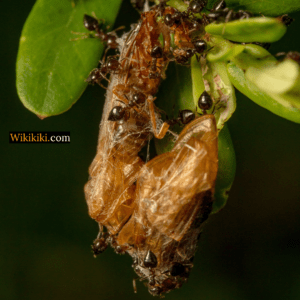Ants are some of the most fascinating creatures that roam the earth. With over 10,000 known species, ants can be found in every corner of the globe, except for the Arctic, Antarctica, and a handful of remote islands.

Ants are easily recognizable by their narrow waist, which separates their abdomen and thorax. Their bodies are covered with a hard exoskeleton, and they come in a variety of colors, with most species being either red or black. The size of ants can range from 1/3″ to 1/2″, depending on the species.
Like other insects, ants have six legs, each with three joints. They also have large heads with compound eyes, elbowed antennae, and powerful jaws. The antennae are essential for their communication and detecting their surroundings, while their jaws are used for foraging, defense, and nest-building.
Types of Ants
There are three types of adult ants in a colony: the queen, female ants, and male ants. Each type of ant has a specific role within the colony.
- Queen Ants: The largest ants in the colony, queen ants have wings and their primary purpose is to lay eggs. Depending on the species and nest community size, there may be one or more queens in the colony. Queen ants can live up to 30 years.
- Female Ants: Also known as workers or soldiers, female ants are smaller than the queen, wingless, and sterile. They care for the eggs, tend to the larvae, build and repair the nest, forage for food, and protect the colony. Female ants can live up to three years.
- Male Ants: Male ants, also called drones, develop from unfertilized eggs. They have wings and are fertile to mate with the queen. Male ants are much smaller than females and have longer antennae. They only emerge from the colony for one day to mate and usually die 10-14 days after mating.
Ant Reproduction
The ant life cycle has four stages of development: egg, larva, pupa, and adult. The queen ant lays the eggs, which hatch into larvae in a couple of days.
The helpless larvae are fed and groomed by the worker ants until they pass through the pupal stage. In a little over a week, an adult ant will emerge, and the metamorphosis is complete.
Ant Habitat
Ants are social insects that live in structured nest communities throughout the world. The species determines their ant habitat, whether they live underground, in mounds built at ground level, in wood structures, or in plants or trees.
Soil and plant matter are typically used to construct the nests. In colder regions, ants become inactive during the winter months. In warmer temperatures and climates, ants continue to be active. Ants are also known to be great farmers, cultivating crops such as fungus to feed their colonies.
Other Fascinating Ant Facts
- Some species of ants have been in existence for around 100 million years. Ants survived a mass extinction event known as Cretaceous-Tertiary that wiped out many dinosaurs and other prehistoric animal species approximately 65 million years ago.
- Although you probably won’t see an ant pumping iron at your local gym, don’t take their tiny size as a sign of weakness. Ants’ unique physiology enables them to carry objects that are up to 50 times their body weight.
- Ants communicate with each other through pheromones, which are chemical signals that they leave behind as they move. These pheromones help the ants to find food, identify nestmates, and communicate about potential threats to the colony.
- Ants are highly organized and have a complex social hierarchy. Each ant knows its role and responsibilities within the colony and works together to accomplish common goals.
- Some species of ants are known to practice slavery, raiding other ant colonies and capturing their pupae to raise as their own workers.
- Ants play an important role in ecosystems as they help to break down organic matter and aerate soil, allowing for better plant growth. They are also an important food source for many animals, such as birds and lizards.
- Ants have been used in traditional medicines for their antibacterial and anti-inflammatory properties.















+ There are no comments
Add yours